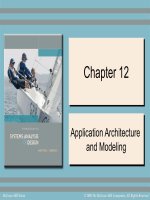Lecture Introduction to occlusion
Bạn đang xem bản rút gọn của tài liệu. Xem và tải ngay bản đầy đủ của tài liệu tại đây (722.22 KB, 14 trang )
INTRODUCTION TO OCCLUSION
Part one
ANATOMY AND PHYSIOLOGY
OF THE MASTICATORY SYSTEM
Chapter 1: Introduction
Masticatory System
Definition of Occlusion
Chapter 2: Functional Anatomy of Masticatory System
Temporomandibular Joint
Skeletal Components of Masticatory System
Masticatory or Jaw Muscles
Chapter 3: Considerations of Occlusion
Development of Deciduous Dentition
Development of Permanent Dentition
Considerations of Occlusion
Chapter 4: Kinesiology of Occlusion
Classification of Positions and Movements of the Mandible
Border Movements and Positions of the Mandible Recorded
in the Sagittal Plane
Border Movements and Positions of the Mandible Recorded
in the Horizontal Plane
Chapter 5: Functions and Parafunctions
Functions: Swallowing (Deglutition), Suckling, Chewing, Speaking
Parafunctions: Bruxism, Clenching
§ INTRODUCTION TO OCCLUSION
Goal:
After studying this lesson, the student should be able to:
1. present the concept of masticatory system and name the components
of the masticatory system.
2. define the subject of occlusion; differentiate from teeth
articulation or contact between the teeth and occlusion
1. MASTICATORY SYSTEM
Individual tooth is of great clinical significance. A single tooth, by itself, however,
can not perform the necessary masticatory and occlusal functions.
When the teeth are properly related to each other to form the dental arches and
the dentition, they become an essential component of the masticatory system.
1.1. Masticatory System and its Components
The masticatory system as a whole forms a functional unit, consisting of the
teeth and periodontium, the jaws, the temporomandibular joints, muscles
involved in moving the mandible (jaw muscles), the lip-cheek-tongue system,
the salivary system, the neuromuscular and vascular structures involved in the
control, nutrition and maintenance of proper function.
→ Masticatory system is a multicomponent and multifunction system
1.2. GENERAL FUNCTIONS of the human masticatory system
The head houses and protects a number of anatomical structures which are
necessary for the maintenance of life and well-being of the individual.
→ The masticatory system is but one of several functional units that use
anatomical structures in common with other systems.
The Two Group of Functions of Masticatory System:
- Primitive or biological functions: swallowing (deglutition), suckling, chewing
- Social functions: Communication functions: including speaking, aesthetic...,
and Emotional expression...
The functions of "tools" and "weapons" are still expressed, but do not play a
decisive role and no longer play the role of a meaningful function of life.
2. DEFINITION OF OCCLUSION
“Occlusion” is one of the most commonly word used by the dental profession.
The term “occlusion” is defined in the dictionary as
“the act of closure or state of being closed”
The Subject of Occlusion:
‒ is NOT limited to the occlusal contact relationship of the teeth
‒ implies much more than the static occlusal contact relationships of the teeth
‒ should includes reference to a dynamic biomechanical musculoskeletal system
‒ encompasses neuromuscular and psychophysiologic areas that may reflect
disturbances that occur as a result of, or are the cause of occlusal dysfunction
‒ should have in its definition the concept of a multifactorial functional
relationship between the teeth and other components of the masticatory system
as well as with other areas of the head and neck that directly or indirectly
related to function, parafunction, or dysfunction of the masticatory system.
Occlusion is defined in many statements:
“The relationship between all the components of the masticatory system in
normal function, dysfunction and parafunction, including the morphological and
functional features of contacting surfaces of opposing teeth and restorations
occlusal trauma and dysfunction, neuromuscular physiology, the
temporomandibular joint and muscle function, swallowing and mastication,
psychophysiological status, and the diagnosis, prevention, and treatment of
functional disorders of the masticatory system” (Jablonski, 1982).
“Occlusion is the dynamic biological relationship of all components of the
masticatory system to the contacting surfaces of the teeth in function and
dysfunction, i.e. the integrated function of jaw muscles, temporomandibular
joints and teeth” (Klineberg, 1991).
Occlusion is a subject of the relationship of all components of the masticatory
system that related to the contacting occlusal surfaces of the teeth in function,
parafunction and dysfunction. These relationships are presented mainly on three
main components: teeth and periodontal tissues, temporomandibular joints and
jaw muscles, which are accumulated over time under certain psychophysiological
status conditions.
Tooth-Tooth contact
Tooth-Tooth contact
Tooth-Tooth contact
DEFINITION OF OCCLUSION
Occlusion is the subject of the relationship of
all components of the masticatory system
that related to the contacting occlusal
surfaces of the teeth in function,
parafunction and dysfunction.
These relationships are presented mainly
on three main components: teeth and
periodontal tissues, temporomandibular
joints and jaw muscles,
which are accumulated over time under
certain psychophysiological status conditions.
Note: Articulation: in dentistry, the
static and dynamic contact
relationship between the occlusal
surfaces of the teeth during function
Teeth &
Periodontium
T -T
Jaw Muscles
TMJs
Time
T – T = tooth–to-tooth contact
The Central Role of Occlusion in Dental Education and Practice
Occlusion is a complex subject and one of the basic building stones of dentistry.
It is special importance to the provision of comprehensive patient care in clinical
practice
In dentistry, the subject of Occlusion is in the unique position to provide a
common pool of information that can be used by all of the clinical disciplines.
The subject of Occlusion is the medium that brings all branches of dentistry
together
“Occlusion is the red thread which go through all specialty of dental practice”.
TEETH & SKULLS IN HUMAN EVOLUTION
Đồ đá cũ - Sơ kỳ
Earliest fire use
pleistocene
(Lower Paleolithic)
“Out of Africa”
Protohistory (Sơ Sử)
Prehistory (Tiền Sử)
pliocene
History
Lịch sử
Trung kỳ (Middle ~)
chimpanzee
Homo habilis
(-2.5 - -1.5 My)
Au. anamensis
(-4.12 My)
Ardipithecus ramidus
(-6# -4.4 My)
Au. afarensis
“Lucy”(3.4 My)
Paranthropus robustus
Homo s. sapiens
(100,000 Y)
H. s. neanderthalensis
(-230,000 Y)
Au. Africanus
Interglacial periods (Quaternary glaciation: -2,588,000y to present)
holocene
H. erectus Thẩm Khuyên
Homo erectus
(-1.8 M – 400,000 Y )
Archaic Homo sapiens
(- 300,000 Y)
3. EVOLUTIONAL CHARACTERISTICS OF THE HUMAN MASTICATORY SYSTEM
The main dento-facial changes in comparing between modern man and Homo
habilis, Homo erectus and Neanderthal man include:
A reduction in size of teeth and a reduction in
number of cusps in the permanent molars,
but little change in tooth form,
A greater reduction in size of alveolar processes with
a loss of facial prognathism and increasing tendency
for crowding of teeth
The development of the characteristic chin of
modern man
Homo erectus
H. sapiens neanderthalensis
H. sapiens sapiens
3. EVOLUTIONAL CHARACTERISTICS OF THE HUMAN MASTICATORY SYSTEM (cont’d)
The relative proportion of cranium to jaws has
changed in human due to both an increase in
cranium size and decrease in jaw size
These evidences of evolution and comparative
anatomy of the masticatory system can explain the
potential of abnormal function in human
The TMJ is a special structure of the masticatory
system in terms of anatomy and evolution:
the “temporal” is a part of the cranium that
increase in size
the “mandible" is a part of the masticatory system,
→ TMJ is affected by two trends of evolution at the
same time
Homo erectus
H. Sapiens neanderthalensis
H. Sapiens sapiens









